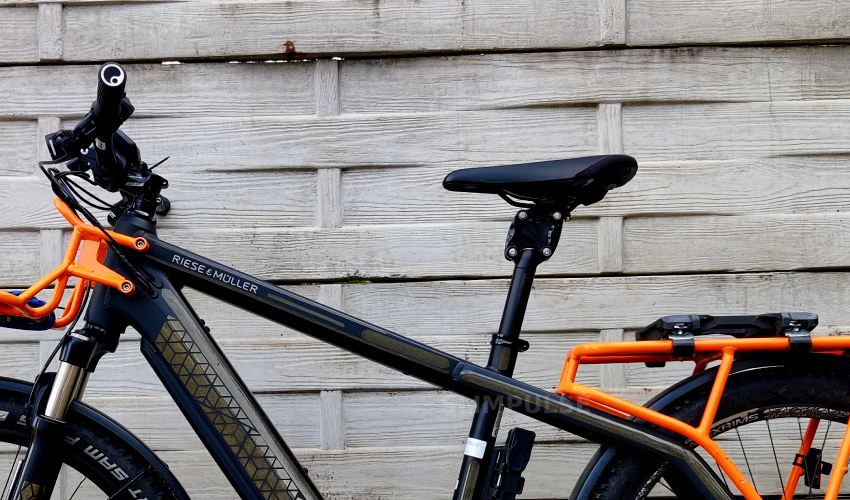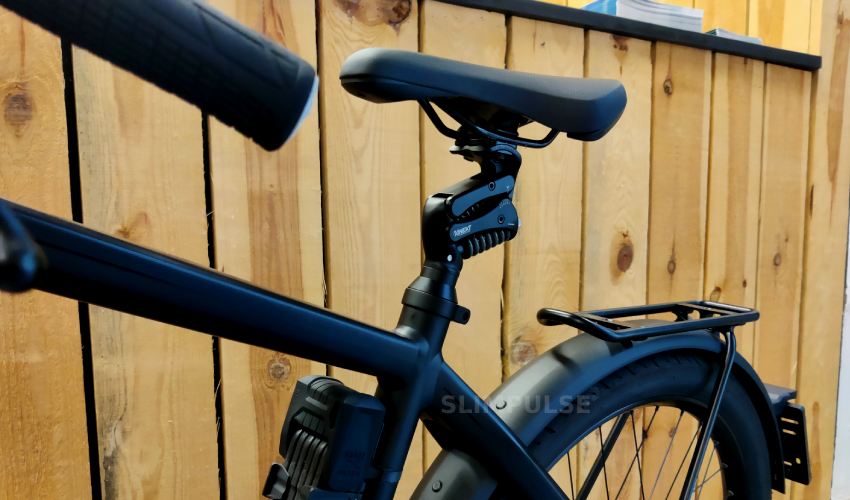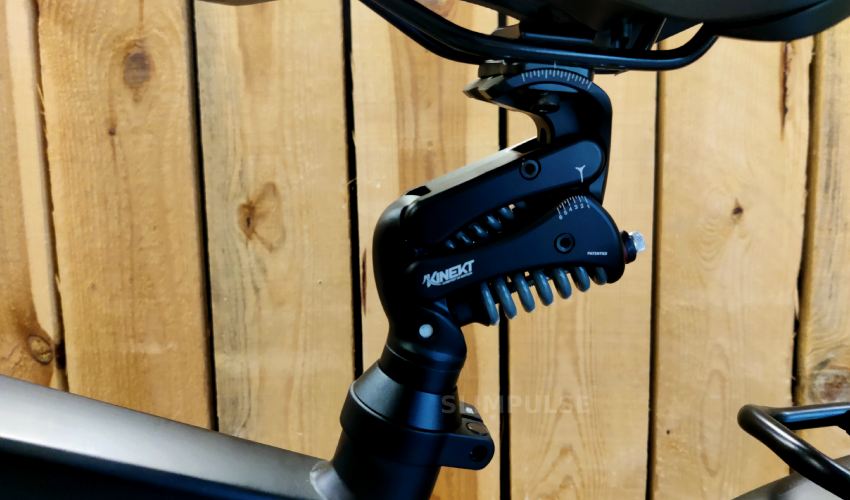Quick search
You’re cycling along a path. The sun is shining, the air is fresh, and you feel free. But then, a series of bumps on the road. Every bump, every pothole is felt, resonating through your entire body.
This moment, however brief, reminds you that not every aspect of cycling is equally pleasant. Suspension is not always standard on every bike. By omitting suspension, the manufacturer can keep the price down. Depending on your route, you may or may not need this.
This article is for anyone looking to improve the comfort and control of their bike, regardless of the route or type of bike. Whether you’re riding through the city, along rural roads, or exploring adventurous trails. Please note, this is an informative article where we don’t discuss brands and products. If you’re looking for guidance, read our comprehensive comparison of seatpost suspensions.
This article is for all cyclists. Keep this in mind when reading this information, which information is relevant to you. Also consider your type of (electric) bike to interpret the information correctly.

Different Types of Seatpost Suspension
Telescopic vs. Linkage-Based
First, let’s talk about the design.
Telescopic, think of a telescope that slides in and out, is simple and effective. But it can lead to a change in your saddle height while riding. Cheaper but not ideal.
Linkage-based systems, on the other hand, keep your saddle height constant. Using levers and hinges, they absorb shocks without affecting your position. The result? A smooth ride without compromises.
Now, let’s look at the types of seatpost suspensions. Not every suspension seatpost is the same. There are several different types, different designs that serve the same function.
Elastomer Suspension Systems
Let’s start with the simplest form: elastomer. Elastic, not a real spring.
This system uses rubber or silicone blocks to absorb shocks. It’s like riding with a cushion under your saddle. We see this on our first Multicharger. This provides comfort, but it can be improved.
Elastomer is reliable and low-maintenance, but it has its limits. In cold weather, it can feel harder, and it doesn’t offer the same adjustability as other systems. Still, for light rides on not too rough terrain, it does its job fine.
Coil Spring Suspension Systems
Next, we have the coil spring.
This system, often found in the world of motocross, brings some of that ruggedness to your bike. A metal spring compresses under pressure, absorbing shocks. We often see this offering the best value for money. Also on speed pedelecs, this is a good choice for seatpost suspension.
The beauty of a coil spring is the immediacy of the response. Feel a bump, and the coil spring reacts right away. Adjustability is also a plus, with different spring strengths you can swap to optimize your ride.
However, it’s heavier than other systems, something to keep in mind for sporty, weight-conscious riders who aren’t riding electric.
Air Spring Suspension Systems
Air suspension is where technology really shines. Instead of a physical spring, you’re using pressurized air as damping.
It’s like riding on a cloud, with the biggest advantage being adjustability. With a few pump strokes, you can adjust the stiffness of the suspension, perfect for those who like to experiment with their riding experience.
Lightweight and versatile, air suspension is ideal for both recreational riders and serious adventurers.
So, there are different types of seatpost suspensions, different mechanisms and designs. Keep this in mind as you compare them. Make sure you’re comparing the same type with each other, and know which design best suits your use. This article is for everyone; only you know if you’re reading this as a mountain biker, as the owner of an electric cargo bike, or as a speed pedelec rider.
So, make sure your choice fits your biking experience best. First, choose the type of seatpost suspension, then you can continue comparing based on various factors.
Let’s delve deeper into some of these important comparison factors, and how to interpret this when looking closely at the products.

1. Suspension Travel
The suspension travel of a suspension seatpost, expressed in millimeters, indicates how much the seatpost can move vertically to absorb shocks.
For light, everyday rides on relatively flat terrain, you may be fine with a suspension seatpost with shorter travel, around 20 mm. But if you seek adventurous trails with lots of roughness, a travel of 50 mm or more can be beneficial.
It’s not just about terrain; speed matters too. If you’re riding a speed pedelec, you’ll want more travel compared to a simple electric bike.
It’s a balance between comfort and efficiency; too much travel can make cycling heavier on flat terrain, while too little travel may not provide the comfort you seek on rougher terrain.
Let’s delve deeper into this, with some examples and our opinion. But remember to test for yourself; much depends on you as the rider.
- City/Urban Bikes: For everyday rides on relatively flat and smooth terrain, a suspension seatpost with short travel, around 20 mm, is often sufficient. These bikes benefit from a subtle improvement in comfort without the need for extensive suspension.
- Electric Bikes: E-bikes, especially models capable of reaching speeds up to 45 km/h, can benefit from a seatpost with longer travel (around 50 mm or more), given the higher speeds and increased likelihood of road irregularities. Longer travel helps absorb the extra vibrations and shocks.
- Road Bikes: For road bikes, the emphasis is primarily on speed and efficiency, and less on comfort. A short travel or even a stiff, non-suspension seatpost may be preferred to minimize energy loss. However, for riders who value comfort on long distances, minimal travel may still be desirable.
- Mountain Bikes: For mountain biking, where the terrain is often rough and unpredictable, longer travel is essential. Seatposts with a travel of 50 mm or more can significantly contribute to control and comfort on technical trails.
- Speed Pedelecs: For fast speed pedelecs reaching up to 45 km/h, a good travel of 50 mm or more is recommended. Quality and durable design also play a role at these high speeds.
Impact of Existing Suspension on the Bike
If your bike is already equipped with front and/or rear suspension, this may reduce the need for a long-travel seatpost.
The overall bike suspension already helps absorb much of the impact. In such cases, a seatpost with medium travel can offer a good balance between extra comfort and maintaining efficiency.
The Role of Your Weight, Height, and Riding Position
- Weight and Height: Heavier or taller riders may benefit from a seatpost with higher preload or longer travel to compensate for the extra force on the seatpost.
Lighter riders, on the other hand, may opt for a softer setting. The rider’s height can also influence the choice of seatpost length to ensure optimal seating position. - Riding Position: Riders who prefer a more upright position, such as often found in city or e-bikes, may find more comfort in a seatpost with longer travel, as more pressure is exerted on the saddle.
Riders who ride in a forward-leaning position, such as on road bikes, exert more pressure on the pedals and handlebars, reducing the need for suspension in the seatpost.
2. Preload Adjustment
Preload adjustment is a setting that determines the initial tension of the spring in your suspension seatpost. This affects how easily the suspension engages to absorb shocks.
A higher preload is ideal for heavier riders or situations where you desire a firmer ride. For lighter riders or a softer response to bumps, you can opt for a lower preload. The trick is finding the right preload that offers comfort without sacrificing too much energy during pedaling.
The process of adjusting preload varies depending on the type of suspension seatpost you have. In many models, preload is adjusted using a dial at the top or bottom of the seatpost, or by changing the air pressure in the case of air-sprung seatposts.
- Start with a baseline setting: Consult your seatpost manual for a recommended starting point based on your weight.
- Test and evaluate: Ride on a familiar course and observe how the suspension reacts. Does it feel too soft or too hard?
- Adjust and repeat: Fine-tune the preload based on your experience. Increase the tension if the suspension sags too easily, or decrease it if you want more responsiveness to smaller bumps.
Tips for Adjusting Suspension Seatpost
- Make small adjustments: Large changes in preload can drastically alter the riding experience. Start with small adjustments and build from there.
- Consider your route: If you plan to ride mostly on rough terrain, consider a softer setting. For predominantly smooth roads, consider a firmer setting.
3. Material and Design
Choosing the right materials and design for your suspension seatpost is crucial for the overall riding experience and performance of your bike. Here’s a deeper look at how to understand these factors and what they mean for you as a consumer:
Aluminum Suspension Seatposts
This is a lightweight and strong material commonly used in the bike industry. It offers a good balance between durability and cost.
Aluminum seatposts are rugged and capable of withstanding most riding conditions, making them an excellent choice for daily commuting and recreational cycling.
Carbon Suspension Seatposts
Carbon seatposts are even lighter than aluminum and provide excellent vibration damping, which can contribute to a more comfortable ride, especially on long distances or rough terrain.
However, carbon is more expensive and may be less suitable for extremely rough use where the likelihood of impact is high. In such cases, steel models offer the best support.
Steel Suspension Seatposts
Though heavier, steel is known for its exceptional durability and resilience.
Steel seatposts can be a good choice for touring or adventurous cycling where the extra strength and longevity justify the increase in weight.

4. Damping
Damping refers to the mechanism that regulates the speed at which the suspension compresses and rebounds.
Good damping ensures that your seatpost doesn’t feel too bouncy and efficiently absorbs shocks. It also helps to quickly return the seatpost to its original position after an impact.
Without adequate damping, your seatpost could feel like a pogo stick, which is not only uncomfortable but can also reduce your control over the bike.
How Damping Works
In suspension seatposts, damping is typically achieved through an internal mechanism that controls the movement of the spring.
This can be fluid damping, where the movement of oil through small apertures regulates the speed of the spring, or mechanical damping, where physical resistances limit the movement.
When you ride over an obstacle, the spring absorbs the initial shock, while the damping system controls the speed at which the spring compresses and expands.
The Importance of Good Damping
- Control: Good damping provides more control over the bike. You remain more stable in the saddle, even on technical terrain.
- Comfort: By gradually absorbing shocks and smoothly returning the seatpost to its original position, good damping significantly increases comfort.
- Efficiency: Efficient damping prevents energy loss. Instead of all the shock energy being directed back into the body, it’s absorbed and controlled, reducing fatigue and helping you ride longer and more comfortably.
Evaluating Damping
When choosing a suspension seatpost, it’s important to pay attention to the type and quality of damping. Not all seatposts offer the same levels of damping or adjustment settings.
Some more advanced models offer adjustable damping, allowing you to tailor the seatpost’s response to your weight, riding style, and the conditions in which you ride. This is especially useful if you vary between different types of terrain.
5. Adjustability of Suspension Seatpost
Some suspension seatposts offer customizable options, such as the ability to adjust travel, preload, or damping.
This adjustability allows you to fine-tune your seatpost to your specific weight, riding style, and riding conditions. Especially with air suspension systems, where you can adjust air pressure, this provides a high degree of flexibility.
Adjustability of Elastomer Suspension
Elastomer suspension seatposts offer limited adjustability. You can sometimes adjust the hardness by using different elastomers, but the options are often limited to the hardness grades provided by the manufacturer.
This type is simple and low-maintenance but doesn’t offer the same level of fine-tuning as air or coil spring systems.
Adjustability of Coil Spring Suspension
With coil spring suspension seatposts, you can often replace the spring for one with a different spring rate (hardness), allowing you to tune the seatpost to your weight and riding style.
Some models also offer the ability to adjust preload, refining the spring’s response to your weight without having to replace the spring itself.
Adjustability of Air Spring Suspension
Air suspension offers the highest level of adjustability. By changing the air pressure, you can finely tune the spring response to your weight and riding conditions.
This system allows for quick and easy adjustments, making it ideal for riders who want to optimize their setup for different terrains or personalize their riding experience.
Understanding this adjustability per type of suspension is crucial for choosing the right suspension seatpost.
Riders looking for the most flexibility and fine-tuning will likely prefer air suspension systems, while those seeking simplicity and ease of maintenance may be satisfied with elastomer or basic coil spring systems.
6. Ease of Installation
When considering purchasing a suspension seatpost, it’s important to look beyond just the performance and comfort it can provide. Consider practical aspects such as ease of installation, adjustability of saddle height, length of suspension for different rider heights, and compatibility of seatpost diameter with your bike frame.
Most suspension seatposts can be installed using standard bike tools.
Some models may require specific adjustments or settings that require special tools. Check product descriptions and manuals to determine if additional tools are needed.
Saddle Height and Suspension Length
Adjustability of Saddle Height:
The ability to precisely adjust saddle height is crucial for both comfort and efficiency while riding. Ensure that the suspension seatpost provides enough room for fine adjustments to your ideal saddle height.
Suspension Length for Rider Heights:
Tall riders may require a seatpost with longer extension to maintain a comfortable and ergonomic riding position, while shorter riders may benefit from a model with less protrusion above the frame for easy mounting and dismounting.
-
- For tall riders: Look for models with a longer minimum insertion and sufficient overall length.
- For short riders: Ensure that the seatpost can be shortened enough to achieve the desired saddle height without the suspension getting in the way.
Diameter Compatibility
The diameter of suspension seatposts is not universal. The most common diameters are 27.2 mm, 30.9 mm, and 31.6 mm, but other sizes are also available. It’s essential to measure or check the inner diameter of your bike frame’s seat tube or consult your bike’s specifications to choose the correct size.
Shims/Adapters
If the suspension seatpost you’ve chosen doesn’t exactly match the diameter of your frame, shims or adapters are available to allow fitting a smaller seatpost into a larger tube. These should fit snugly and without play to ensure safety and stability.
Our Opinion on Suspension Seatposts
A suspension seatpost can truly make the difference between comfort and frustration on the bike. It can also have the opposite effect. A good suspension seatpost works wonders, but a wrong choice won’t solve the problem.
The quest for the perfect suspension seatpost may feel like searching for a needle in a haystack. But armed with the knowledge from this article, you’re now able to not only find that needle but also understand why it’s precisely the needle you need.
Of course, don’t think that you know everything perfectly after reading. Go out and test; only then will you gain the necessary experience to make the right choice.
Remember, the choice you make today for a suspension seatpost can enhance the quality of your biking experiences tomorrow. This is your chance to transform the way you ride, to embrace comfort and control, and to make every ride an experience you won’t want to miss.

